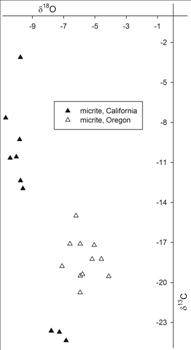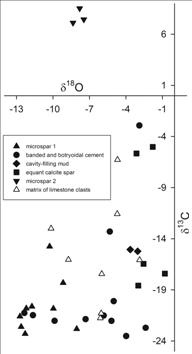58th Annual Report on Research 2013 Under Sponsorship of the ACS Petroleum Research Fund
Reports: UR851198-UR8: Brachiopod Shell Beds as Indicators and Predictors of Ancient Hydrocarbon Seeps: Assessing their Geological, Paleoecological, Evolutionary and Biostratigraphical Significance
Michael Sandy, PhD, University of Dayton
Activity included field work, laboratory work, presentation of results at meetings, and publication of results. Investigation of brachiopod-bearing deposits of possible hydrocarbon-seep origin include Jurassic occurrences from Oregon and California, Jurassic-Cretaceous of Svalbard, and the Cretaceous of Tibet.
Jurassic of USA
Collaborative research with Professor Jörn Peckmann (Vienna) and other colleagues has resulted in the identification of four new records of the rhynchonellid brachiopod genera (Superfamily Dimerelloidea) Anarhynchia and Sulcirhynchia from hydrocarbon-seep deposits. This marks the first confirmed occurrence for the Jurassic brachiopod Anarhynchia in such an association (although it had previously been suspected but not substantiated, e.g., Sandy, 1995).
The association of Anarhynchia with both hydrocarbon-seeps and hydrothermal-vent deposits (Jurassic of California, Little et al., 2004) make this taxon unique, being the only post-Paleozoic brachiopod currently identified from both environments. ACS-PRF supported field work has resulted in the re-discovery of Anarhynchia localities – in isolated limestone pods in clastic-dominated sequences near Seneca, Oregon, and in boulders in a grassy meadow in Bedford Canyon, California. These localities were first mentioned in the literature in the middle decades of the twentieth century –the 1940s (Lupher, 1941) and 1960s (Hallam, 1965) for the Oregon locality, and the Bedford Canyon locality in the 1950s (Silberling, 1959).
The monospecific mass-occurrences of Anarhynchia from Oregon are reminiscent of other localities interpreted as hydrocarbon-seep deposits. The dark micritic limestones yielded negative d13C values of -20.1‰ to -15.0 (OR) and -23.7‰ to -3.1‰ (CA) reflecting hydrocarbon oxidation (Figure 1). The brachiopod-rich deposit formed at a hydrocarbon seep, but it is not possible to determine further the composition of the fluids.
Figure 1 – Isotope plots for Anarhynchia from California and Oregon (Sandy and Peckmann, 2012).
For the other brachiopod genus mentioned, Sulcirhynchia, recent research has confirmed the first occurrence of this genus from a hydrocarbon-seep deposit. The brachiopods are from an unusual limestone body of Jurassic-age in the Blue Mountains Province of eastern Oregon. This limestone deposit, also in the vicinity of the town of Seneca, coincidentally as with Anarhynchia mentioned above, is characterized by a mass occurrence of a dimerelloid brachiopod assigned to the species Sulcirostra paronai. The limestone body with brachiopods is enclosed in serpentinite along with small pods of Sulcirostra limestone and exotic mudstone blocks scattered in its periphery. The brachiopod limestone predominantly consists of early diagenetic phases including clotted micrite and fibrous, banded and botryoidal cement. Negative d13C values of these carbonate phases as low as -23.5‰ (Figure 2) reveal that their precipitation resulted from the oxidation of hydrocarbons, confirming that the brachiopods lived at a seep on the Early Jurassic seafloor. The age assignment is based on Sinemurian ammonoids in association with Sulcirostra from exotic blocks attributed to the Keller Creek Formation. The occurrence of the Sulcirostra limestone within serpentinite calls for an evaluation of the possibility that the Jurassic chemosynthesis-based ecosystem was driven by serpentinization, given the presence of chemosymbiotic communities on the modern seafloor where hydrogen and methane anomalies are generated by serpentinization. The nature of the contacts between the blocks of sedimentary rock including the Sulcirostra limestone and the surrounding serpentinite reveals that these lithologies were juxtaposed by tectonic processes, likely thrusting of the Keller Creek Formation rocks over the serpentinites. No unambiguous evidence has been found that supports a derivation of seepage fluids from serpentinization, yet it is obvious that Sulcirostra lived at a hydrocarbon seep.
Figure 2 – Isotope plots for Sulcirhynchia from Oregon (Peckmann et al., in press).
Jurassic, UK
The Early Jurassic Marlstone Rock Bed brachiopod fauna is a brachiopod-dominated horizon that can be traced from SW England to northern Scotland over some 800 km. Work continues to evaluate the species composition and geographic variability of this fauna. This brachiopod mass-occurrence horizon is considered significant as a precursor to a major environmental perturbation, the early Toarcian anoxic event.
Jurassic-Cretaceous, Svalbard
Work continues on a series of recently discovered hydrocarbon seeps from Svalbard (Hammer et al., 2011). A number of these small seep deposits (< 2m diameter) contain brachiopods (amongst other taxa) and this Jurassic-Cretaceous boundary fauna continues to be studied. Several brachiopod species are present but they do not numerically dominate the seep deposits as in the case of the Oregon Jurassic occurrences mentioned above. Therefore this is considered a quite different, at present, unique, occurrence for brachiopods at hydrocarbon seeps. The main focus for this current year will be on this fauna with undergraduates involved in the preparation of serial sections necessary to determine the faunal content. The work is in collaboration with colleagues from the University of Oslo, Norway.
Cretaceous of Tibet
The Cretaceous brachiopod Peregrinella is one of the largest of the Mesozoic brachiopods and both its highly disjunct distribution and its mass occurrence in isolated carbonate lenses (cf. Anarhynchia and Sulcirhynchia) have attracted much attention (e.g., Ager, 1965; Thieuloy, 1972). Peregrinella has been recorded from remote localities in Tibet (Sun, 1986); the material investigated is from the Chebo section, northern Tibet. The rock contains petrographic seep indicators such as clotted micrite and banded botryoidal cement. These phases yielded negative d13C values of -24.5‰ to -21.9‰. The brachiopod-rich deposit formed at a hydrocarbon seep, but it is not possible to determine further the composition of the fluids. For Peregrinella this marks the fourth record of the genus from hydrocarbon-seep deposits (previous records are from California, Campbell et al., 1993; the Crimea, Kiel and Peckmann, 2008; and Romania, Sandy et al., 2012) thereby suggesting that this genus may be only associated with fossil hydrocarbon-seep environments, hinted at by its disjunct distribution and absence from marine shelf environments.
The research opportunities provided by the grant to undergraduates are invaluable. It allows the students to become immersed in all aspects of the research experience allowing them to consider more thoughtfully their vocation as a scientist. Being able to facilitate this through the ACS-PRF supported research is very rewarding, as is the fact that scientific advances are being made with the involvement of our undergraduates.
Copyright © 2014 American Chemical Society













